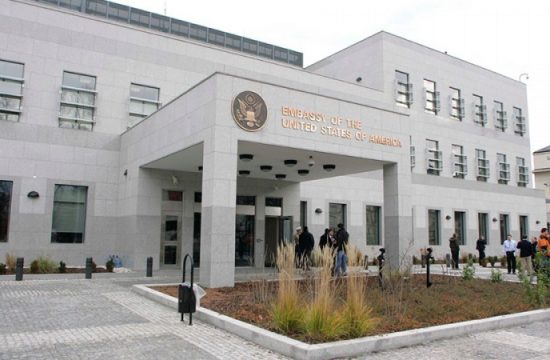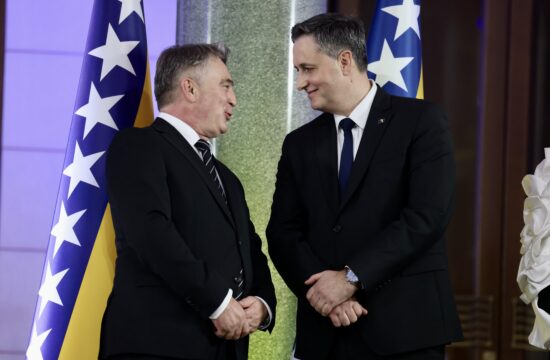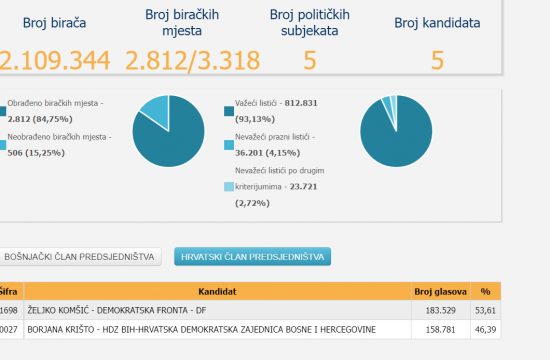People across Bosnia are commemorating the victims of the massacres committed in the northern town of Prijedor during the 1992-1995 war. In Sarajevo, the offices of several NGO’s are covered with white sheets, while in Zenica, students of the local Law Faculty organised a commemorative walk and laid flowers at a local monument for the victims.
When Bosnian Serbs took exclusive control of Prijedor in 1992, they ordered the non-Serb population to wear white ribbons around their arms and put white sheets in their windows. The massacre that ensued in the town claimed the lives of 3,176 non-Serbs, including 102 children.
This is why Bosnians, but mainly Bosniaks, across the country and around the world are sporting white ribbons each year on May 31, ‘White Ribbon Day’.
The Union of Inmates of Concentration Camps of Bosnia and Herzegovina has put white sheets in the windows of its Sarajevo office.
Employees and volunteers from the Museum of Crimes Against Humanity and Genocide 1992-1995 in Sarajevo are distributing white ribbons to passersby in downtown Sarajevo.
“We distribute white ribbons to citizens on the street and visitors of our Museum in commemoration of all the victims against which crimes in Prijedor were committed between 1992 and 1995,” said the curator of the Museum, Sejla Basic.
“We make an effort to raise citizens’ awareness about what happened in Prijedor. In the museum we have exhibits, photos (…),” she added.
The office of Bosnia’s Islamic Community is also displaying a white sheet on its building.
A couple from Switzerland was among those who took a white ribbon in downtown Sarajevo on Thursday.
“We didn’t know about this campaign, but we joined it. We don’t know much about what happened. Our tourist guide gave us information about the war,” they said.
Meanwhile, a group of students at the Faculty of Law in the town of Zenica, just northwest from the capital, organised a commemorative walk from their university to the ‘Kameni Spavac’ monument, where they laid flowers for the Prijedor victims.
They carried a white sheet on which they wrote “May this never happen to anyone, may this never be forgotten,” as well as banners with hand prints of 102 children, representing the number of children killed in Prijedor.

“It is sad that today, after more than 20 years, genocide – let’s call it that way – is being denied by those who were the occupiers then,” said Vinko Stjepic, freshman of the Zenica Law Facutly.
“The history of Bosnia and Herzegovina is complicated, and everyone has his own story, but we need to learn it as it was, so it does not repeat itself. Even in this post-war period, Bosnia lives in that war period and it is always healing from the war, fascism and nationalism,” Stjepic said.
“We thought that after WWII such ribbons will never happen again,” assistant professor at the Faculty, Ajdin Husejnspahic, said.
“It was a painful act when you had to cover your house with a white sheet or put a white ribbon on your arm to mark yourself as a target,” he said, adding that “more than 3,000 innocent victims, of which 102 were children, represent the genocidal intention which was, unfortunately, never recognized in a trial.”
He named the verdict against Dusko Tadic, who was sentenced to 20 years in prison for crimes against humanity committed in Prijedor. “(…) and he will remain a negative symbol for those neighborly relations.”
“That was a time when many neighbors committed these crimes against non-Serbs in Prijedor, but also a time when many Serb neighbors were saving Bosniaks and Croats,” he said, adding that many of those who helped the victims are afraid to speak about their deeds publicly today.
“We here are sending a message of coexistence, tolerance, peace but with the statement that we should never forget what happened,” he said.
The important thing is, he said, that the Zenica commemoration was organised by students who were not even born when the war took place.
“Today’s gathering is important because it was organised by students born in 1998 and 1999, and they don’t know what it was like, but it was their initiative and despite all the exams and obligations they have, they came to show how aware students who want to look toward the future are,” Husejnspahic said.




